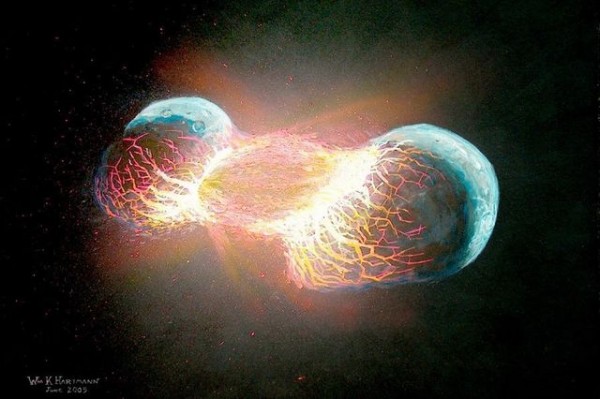By Ana Verayo, | January 30, 2016

The extremely similar chemical composition of rocks on the Earth and moon helped scientists determine that a head-on collision, not a glancing blow, took place between Earth and Theia.
A new study suggests that the moon was created from a planetary collision between Earth and a planetary embryo known as Theia that occurred 100 million years before the moon was formed.
Like Us on Facebook
Prior studies have shown that a high velocity impact transpired between Earth and Theia where the two brushed against each other. In this new study however, new evidence suggests that this was apparently a violent, head on collision between the two cosmic objects.
In this new study, author of the study Edward Young along with his team from University of California, Los Angeles, analyzed several moon rock samples from NASA's Apollo 12, 15 and 17 missions including six volcanic rocks from the Earth's mantle, carrying out a series of chemical analyses. They discovered that both rocks possess the same oxygen isotopes, the very same ones that are present on Earth.
However, this new study is contradicting a prior study from 2014 stating that lunar rocks possess a unique ratio of oxygen isotopes that are entirely different from Earth's. This new study, however, says that a side sweeping collision between Earth and Theia could have been highly unlikely, since it would mean that the moon should have a major composition of material from Theia, which is entirely different from Earth's.
The researchers focused their studies on oxygen atoms, where 90 percent of the rocks' volume and 50 percent of its weight are made from oxygen. On Earth, the majority if oxygen are referred as O-16 oxygen since every atom contains eight protons and eight neutrons with traceable amounts of heavier oxygen isotopes.
Scientists have identified these heavier isotopes as O-17 and O-18 which have one and two additional neutrons. Also, these heavier oxygen isotopes are also found in every planet in the solar system, where scientists have traced these isotope signatures using specialized scientific equipment on Earth and moon rock, discovering that these ratio of oxygen isotopes found on the moon and Earth are nearly identical.
This isotope signature evidence reveals that the collision between Earth and Theia was no simple brush off, according to researchers. Young says that Theia is now incorporated thoroughly into Earth and the moon which is now evenly distributed in the Earth's composition and the moon's as well.
Researchers also believe that if Theia would have survive this colossal impact of planetary proportions, it would have transformed into a planet with a size similar to Earth or Mars. Scientists also believe that this impact with Theia would have removed any trace of water on an infant Earth where shortly after, a swarm of small asteroids would have brought back the planet's water supply, after millions of years after this collision.
This new study is published in the journal Science.
-
Use of Coronavirus Pandemic Drones Raises Privacy Concerns: Drones Spread Fear, Local Officials Say

-
Coronavirus Hampers The Delivery Of Lockheed Martin F-35 Stealth Fighters For 2020

-
Instagram Speeds Up Plans to Add Account Memorialization Feature Due to COVID-19 Deaths

-
NASA: Perseverance Plans to Bring 'Mars Rock' to Earth in 2031

-
600 Dead And 3,000 In The Hospital as Iranians Believed Drinking High-Concentrations of Alcohol Can Cure The Coronavirus

-
600 Dead And 3,000 In The Hospital as Iranians Believed Drinking High-Concentrations of Alcohol Can Cure The Coronavirus

-
COVID-19: Doctors, Nurses Use Virtual Reality to Learn New Skills in Treating Coronavirus Patients







